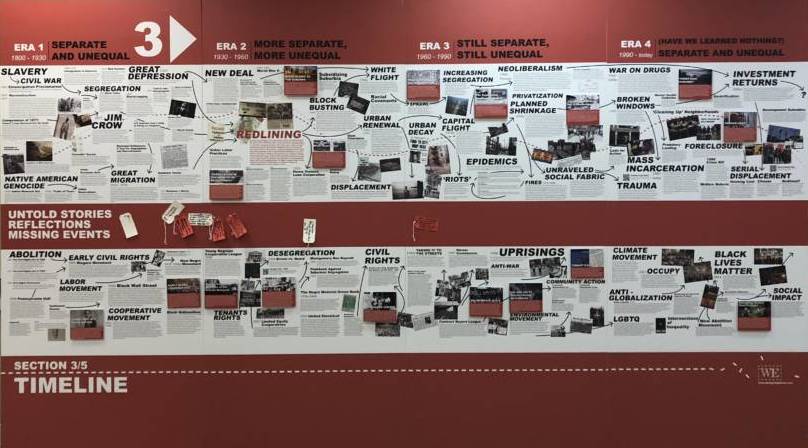At the June meeting of the Housing Association of Nonprofit Developers office in downtown D.C., a 1930s street map of Baltimore hung across a timeline of structural racism in America.
“Undesign the Redline,” is a touring exhibition that showcases the causes and effects of structural racism and classism in communities across America. Originally unveiled in New York City, the exhibit analyzes discrimination in the 20th-century housing market and its effect on shaping low-income communities today.
The practice of redlining, when credit agencies restrict investment in neighborhoods classified as “high risk” or “hazardous,” began in the early 1930s; the practice was outlawed in 1968 under the Fair Housing Act, according to interactive historical maps by Prologue D.C.
The now defunct Home Owners’ Loan Corporation (HOLC) compiled maps of 239 U.S. cities paired with their assessment of real estate development risk for individual neighborhoods within each city. These maps color-code the safest neighborhoods in green and the second safest in blue; yellow is for the inbetweeners leaning towards risky, and red is for the highest-risk areas.
Red neighborhoods were considered unfavorable by investors and as such were starved of the resources and developments made available to green and blue neighborhoods. One of the main factors in determining whether a community was at risk of being redlined was its concentration of African American residents, who were considered a detriment to property values.
Developers in D.C. also commonly sought to implement covenants that restricted certain properties from being sold to Jews and African Americans, according to Prologue D.C. With enough people on board, this could translate into entire blocks of unavailable housing.

“While overt redlining is illegal today … its enduring effect is still evident in the structure of U.S. cities. Part of the evidence of this enduring structure can be seen in the Home Owners’ Loan Corporation (HOLC) maps created 80 years ago, and the neighborhood economic and racial/ethnic composition today. The maps were created by HOLC as part of its City Survey Program in the late 1930s. HOLC deployed examiners across the country to classify neighborhoods by their perceived level of lending risk,” according to research from the National Community Reinvestment Coalition (NCRC), an organization focused on increasing the flow of private capital into traditionally underserved communities.
The interactive exhibit was created by Designing the WE, a “for-benefit” studio that generates earned income but focuses on mission-driven operations, like a nonprofit. Designer and co-founder Rachel De Simone sees redlining as the product of a society that assigns wealth to those who look the part and, by doing so, reinforces inequity.
“Whether we call housing ‘low-income’ or ‘homeless shelter’ or ‘homeless housing’ or ‘supportive housing,’ it’s just housing. We’re all human beings, we need housing,” De Simone said. “How do we begin to educate ourselves that the very vernacular we’re using is predicated on a paradigm of these systems that predate redlining?”
An NCRC report found that redlining effectively set the foundation of segregation in American cities, where most of the neighborhoods that were once considered “hazardous” are now low-to-moderate income (LMI) with mostly minority populations.
Gentrification has resulted in some communication between Black and White people in “hazardous” areas, reported NCRC. But this was found to cause greater income inequality and suggests that “Gentrification probably occurred in the HOLC ‘hazardous’ graded areas because of decades of depressed home values,” according to the report.
“The associated belief that (mainly) African Americans and whites could not live together has persisted. In recent years I’ve heard older African Americans say things like, ‘when you all move in, why do we have to move away?’ In part, that’s based on the fact that when a black family moved onto a block, all the white families moved away,” said Mara Cherkasky, a historian at Prologue D.C.
NCRC noted areas that weren’t racially diverse tended to have a stronger concentration of wealth and resulted in cities with greater income inequality. While this was more commonly seen in cities with strong minority populations, it could indicate less racially and ethnically integrated cities have greater income inequality.
Cherkasky added that Prologue D.C.’s project focuses on historic segregation and discrimination, but has also drawn conclusions about how those forces have shaped the present.
“By painting African American neighborhoods as undesirable/unsuitable for investment, the federal government, as well as the real estate and banking industries, stigmatized African Americans themselves, leading to the belief that their presence in a neighborhood would naturally lead to a decrease in property values,” Cherkasky said.
The Housing Association of Nonprofit Developers hosted the exhibit as the centerpiece of its annual meeting and housing expo, before it was made available to the public at the D.C. Housing Finance Agency for the month of June.
HAND’s annual meeting draws in more than 1,400 housing and community development professionals. This year’s theme was “Deconstruct Our Past, Redesign Our Future.”
Heather Raspberry, executive director of HAND, said that even though redlining is no longer legal, communities once subjected to it are still in need of repair. In order for industry leaders to understand what is needed to help revitalize these communities, Raspberry thought it was critical for HAND to ensure that it integrated takeaways from the exhibition into its conference. The organization wanted to present a convincing demonstration to local developers of how the aftermath of systematic racism persists today.
“We know that housing itself connects to so many other issues that very much are tied to redlining — access to healthcare, having strong schools and the communities where we are working to ensure there aren’t any food deserts.”
Correction (07.16.2018)
This article has been updated to reflect that the Undesign the Redline exhibit was displayed in two D.C. locations, the HAND annual meeting (held at the Shoreham Hotel) and as a public exhibition in the D.C. Housing Finance Agency offices. The article previously misstated the exhibit was displayed in the HAND offices.








